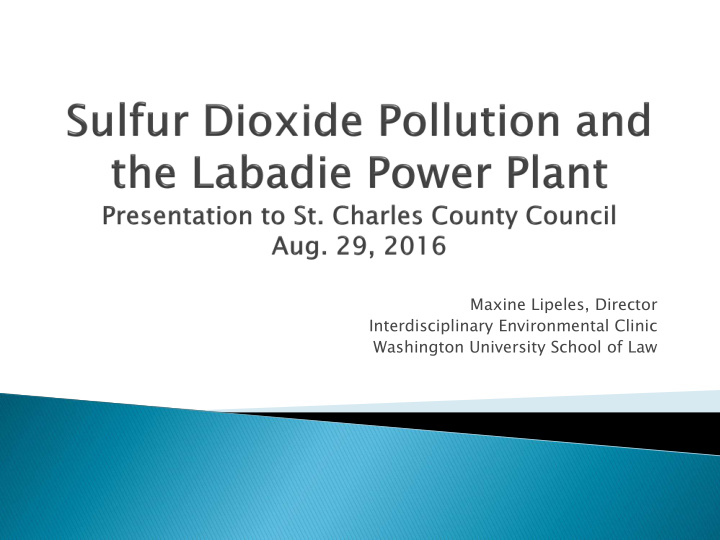



Maxine Lipeles, Director Interdisciplinary Environmental Clinic Washington University School of Law
Required by Clean Air Act Set by Environmental Protection Agency (EPA) Must protect public health Reviewed every 5 years Apply to pollutants with nationwide, health- based concerns: ◦ Carbon monoxide Ozone ◦ Lead Particulate matter ◦ Nitrogen oxides Su Sulf lfur ur dioxide xide
Revised in 2010 to protect public health Short-term, 1-hour standard Health concerns: ◦ “Short -term exposures to SO 2 can harm the human respiratory system and make breathing difficult.” EPA Children, elderly, and asthmatics most at risk SO 2 fine particle pollution ◦ Heart disease, lung disease, premature death
Scrubbers – Flue Gas Desulfurization (FGD) Most effective pollution control for SO 2 Can reduce SO 2 emissions by 98-99% Available since 1970s Capital costs reduced >30% since early 1990s “Wet scrubbers are the most widely used FGD technology for SO 2 control throughout the world.” ◦ International Energy Agency
Scrubbers on 1 of Ameren’s 4 coal plants in Metro St. Louis ◦ Sioux plant in W. Alton ◦ Started late 2010; >98% Less Pollution 75% of US coal plant capacity has scrubbers 19 % of Ameren’s coal capacity has scrubbers
14 th -largest coal-fired power plant in US 3 rd -largest source of SO 2 pollution in US so far in 2016 Largest power plant in US without SO 2 controls More premature deaths than any other coal plant w/o scrubbers
Ameren has told state regulators it expects to install scrubbers at Labadie ◦ Labadie landfill permit application -> DNR “A new flue gas desulfurization (FGD) system is scheduled to be built at the plant in the future.” ◦ Integrated Resource Plan – > Public Service Commission No firm commitment Ameren working hard to avoid installing scrubbers at Labadie
Revised SO 2 standard triggered EPA’s 3 - year deadline for “nonattainment” designations. ◦ Area meeting standard = attainment ◦ Area exceeding standard = nonattainment ◦ Insufficient info = unclassifiable - delays making attainment or nonattainment designation EPA missed 3-year designation deadline for most of the country
Two-step process for remaining designations ◦ Largest plants (inc. Labadie): July 2016 ◦ All others – over the next several years Designations Clean- up plans (“state implementation plans” or SIPs) ◦ Limits on existing emitters to bring nonattainment areas into compliance ◦ If Labadie area “nonattainment,” SIP might require scrubbers to ensure area meets SO 2 standard
DNR recommended unclassifiable (Sept 2015) ◦ Even though DNR and Ameren modeling, using approved EPA modeling protocols, showed nonattainment EPA proposed nonattainment (Feb 2016) ◦ Based on DNR modeling EPA final decision unclassifiable (July 2016) ◦ Rejected new modeling from all parties
Source: EPA Technical Analysis for Franklin County, MO
Unclassifiable modeling or monitoring to make attainment or nonattainment designation Ameren and DNR chose monitoring EPA requires monitors to be located where maximum concentrations are expected (use modeling to determine peak areas)
Ameren set up two monitors in April 2015 DNR approved sites without doing modeling to see whether or not they were in peak areas EPA: Ameren monitors not in peak areas EPA, DNR, Ameren in discussions Outcome?
Recommend
More recommend